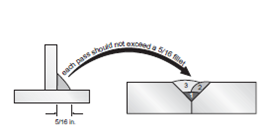
What get's me Larry is not so much the actual size limitation per se although, it would nice to see where in the codes or standards (Possibly in one of the commentaries?) does the location of this rule presumably being based on empirical proof shown or, at the very least written as being mandatory as opposed to a recommendation, suggestion, guideline...
Finally, that illustration has some technical issues that should made aware of to whoever made the drawing...I'll attempt to write an in depth description of the illustration in question as detailed as I can possibly do so... While I do understand the premise of using that illustration to convey your intent Lawrence... I have to disagree with the choice of illustration to use as a visual aid to show your welders, and to whoever else sees it just how big their single pass GMAW welds can be according to your shop standard...
1.) The arrow originating from the "T" joint, and pointing @ the cover layer of the single "V" Groove butt joint has some words written above it stating this:
"each pass should not exceed a 5/16 fillet" Now that may look initially acceptable if one just glances @ the tiny words shown but, a person like myself will catch the ambiguity of that simple sentence and understand that the statement above the arrow in the illustration is technically confusing to say the least... Why do I notice and think that? Because I asked myself this:"How can it be written that each pass of a 5/16th of an inch leg size fillet can be immediately transferred and measured as a 5/16th" leg size fillet weld when once it's deposited into the weld groove of a single "V" groove one sided butt joint then technically speaking, it's no longer a 5/16th leg size fillet weld pass!"
2.) Based on the observation above, I decided to look into this further for the purpose of clarification and I came up with this: First off, we know that the dimensions of a fillet weld are not the same as found when measuring the size of a groove weld... Similar yes, but not the same, and this can be easily verified in AWS A3.0 unless a major revision of the associated definitions have occurred without my knowledge of such a profound change...
3.) So I compared the 2 different weld ed joints and how the parts and dimensions that make up each weld(s) are measured and this is what I observed:
A.) A 5/16th" fillet is generally understood as being a fillet weld with a leg size dimension of 5/16th of an inch or 0.313" (Rounded off from 0.3125"), equivalent to 7.9375mm...
Defined in A3.0 as a "Fillet Weld Size: For Equal leg fillets, the leg lengths of the largest isosceles right triangle that can be inscribed within the fillet weld cross section. For unequal leg fillet welds, the leg lengths of the largest right triangle that can be inscribed within the fillet weld cross section. See Figures 25 (A)-(E)"...
B.) The single V groove weld size is based on different parts to be measured and dimensions... Again going back into AWS A3.0...
"Groove weld size" is defined as:
"The joint penetration of a groove weld." I looked specifically @ Figure 26(b) and, it shows a description of what the groove weld size consists of, and how it is to be measured and dimensioned... Figure 26b shows the term "Joint Penetration or Groove Weld Size" dimension, and is measured starting from the surface of the joint with the opening of the V groove, minus the weld reinforcement to end @ the furthest depth of root penetration within the joint thickness... Or, (AWS 3.0)
"The distance the weld metal extends into the joint root." (It should be written instead as:"The distance the weld metal minus weld reinforcement, extends into the joint root") See Figure 26...C.) I then revisited the illustration Lawrence posted with an arrow originating from the "T" joint, just above the weld face of the "5/16th" fillet weld leg size" shown dimensioned @ the bottom of the flat member of the "T" joint, and reaching out with a curved arrow line across the distance between the T joint, and the V groove butt joint to terminate with an arrow head pointing down towards a weld face of a completed fill or cover pass of the Single "V" groove butt joint... With a depth of bevel approximately 2/3 the thickness of the joint showing in the cross section view of 3 groove weld passes that fill the "V" and, detailing in numerical order the sequence of filling the groove by numbering each pass... Written on top of that same arrow line is this sentence:
"each pass should not exceed a 5/16 fillet". So far I described an illustration representing 2 different types of joints and 2 separately dimensioned weld joint types, one being a T joint with a single pass fillet weld on one side, and another being a butt joint with a single V groove joint design on 1 side only with a depth of bevel 2/3 the thickness of each member, filled with multiple weld passes of groove welds and the other side left alone... Everybody agree with what I just described? Are ther clearly visible differences between the two joint dimensions? I know I do.
Like I said in the beginning that I understood the premise and intent of what you're attempting to convey Lawrence... I get that... I just don't agree that the drawing clearly shows that the fillet weld size is equal to the groove weld size based on how the dimensions between the two are supposed to be measured according to AWS A3.0... Now if you meant that a groove weld face dimension should be equal to the shop standard fillet weld leg size then it should be clearly noted and dimensioned in order to avoid any confusion.


Respectfully,
Henry






































































































